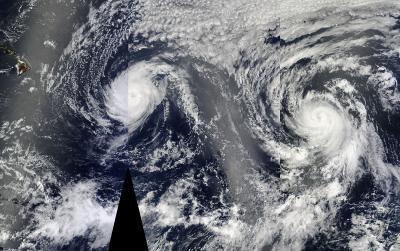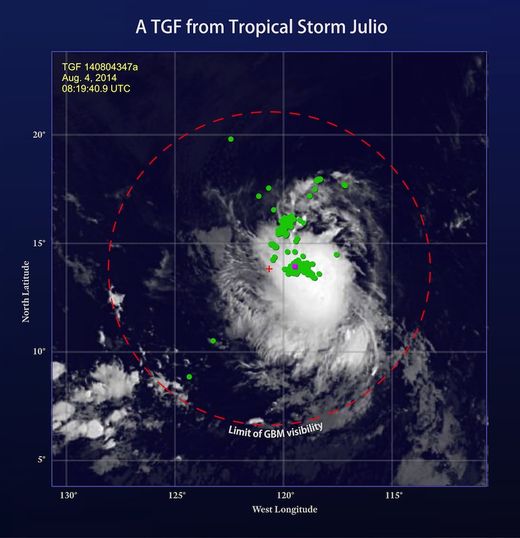
NASA's Fermi Gamma-ray Space Telescope is designed to detect the brightest explosions in the universe - gamma-rays emitted from sources like supermassive black holes or stars that go supernova. But gamma-rays, which are invisible to the naked eye and last only a few thousandths of a second, can also come from sources on Earth.
On Monday (Aug. 4) at 4:19 a.m. EDT (0819 GMT), when Julio was still a fledgling tropical storm hundreds of miles off the coast of Mexico, Fermi witnessed what's known as a terrestrial gamma-ray flash (TGF) above the clouds, according to NASA. [Elves, Sprites & Blue Jets: Photos of Earth's Weirdest Lightning]

TGFs rank among the highest-energy forms of light that naturally occur on Earth, and they can be produced by the powerful electric fields in thunderstorms, which is why they are sometimes called "dark lightning." According to the space agency, there are an estimated 1,100 TGFs every day. Previous research using Fermi data has even shown these bursts can fling antimatter into space.
Scientists have only recently been able to link the phenomenon of dark lightning with specific storms. Fermi, which launched in June 2008, can see TGFs that occur within about 500 miles (800 kilometers) of the telescope, which was not precise enough to determine the exact source of a superquick flash of energy.
But in 2012, scientists showed that big bursts of radio emissions - initially thought to be signals from actual lightning - occur almost simultaneously with TGFs. Now that the two phenomena are associated, researchers can pinpoint the source of gamma-ray flashes with much greater precision, according to NASA.
The World Wide Lightning Location Network, based in Seattle, spotted a lightning-like radio burst near Fermi just 1.89 milliseconds after the TGF was detected. NASA scientists think the two signals must be related.
Julio has strengthened into a Category 3 hurricane as it nears Hawaii. As of 5 a.m. EDT (0900 GMT) today (Aug. 8), the storm was 970 miles (1,560 km) east of Hilo, a city on the Big Island, with wind speeds of up to 120 mph (193 km/h), according to the National Weather Service. Julio is following Hurricane Iselle, which, last night (Aug. 7), became the first hurricane to make landfall on Hawaii in 22 years, though it has since been downgraded to a tropical storm.



It must be Darth Vader's lightsaber.
Dark lightning, also called terrestrial gamma-ray flashes, is a burst of powerful gamma-ray radiation produced in thunderstorms. Two satellites caught a flash of dark lightning just before a lightning bolt raced across a powerful thundercloud in Venezuela in 2006, according to a study published April 15 in the journal Geophysical Research Letters.
Scientists reanalyzed the satellite data with a new processing technique and discovered the one-two punch, which was previously overlooked, lead study author Nikolai Østgaard, a space scientist at the University of Bergen in Norway, said in a statement.
Normal lightning involves slow electrons that carry electric current to the ground or within clouds. In contrast, dark lightning involves high-energy electrons. These electrons slam into air molecules, producing gamma rays. In turn, these gamma rays generate electrons and their antimatter counterparts, known as positrons. These high-energy particles collide into still more air molecules, generating more gamma rays, ultimately explaining many of the properties of the gamma-ray flashes that scientists have detected from thunderstorms.
Ordinary lightning arcs from one spot to another to reduce the voltage growing within clouds. Dark lightning does so as well, and since much higher energy particles are involved, it reduces voltage far more quickly, so the electric fields within them "can collapse in a few tens of microseconds," Dwyer said.